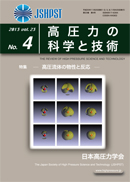23 巻, 4 号
選択された号の論文の14件中1~14を表示しています
- |<
- <
- 1
- >
- >|
巻頭言
-
2013 年 23 巻 4 号 p. 297-298
発行日: 2013年
公開日: 2013/12/28
PDF形式でダウンロード (198K)
特集:高圧流体の物性と反応
-
2013 年 23 巻 4 号 p. 300-308
発行日: 2013年
公開日: 2013/12/28
PDF形式でダウンロード (604K) -
2013 年 23 巻 4 号 p. 309-318
発行日: 2013年
公開日: 2013/12/28
PDF形式でダウンロード (580K) -
2013 年 23 巻 4 号 p. 319-324
発行日: 2013年
公開日: 2013/12/28
PDF形式でダウンロード (359K) -
2013 年 23 巻 4 号 p. 325-331
発行日: 2013年
公開日: 2013/12/28
PDF形式でダウンロード (452K) -
2013 年 23 巻 4 号 p. 332-338
発行日: 2013年
公開日: 2013/12/28
PDF形式でダウンロード (465K)
解説
-
2013 年 23 巻 4 号 p. 339-346
発行日: 2013年
公開日: 2013/12/28
PDF形式でダウンロード (473K)
追悼
-
2013 年 23 巻 4 号 p. 347
発行日: 2013年
公開日: 2013/12/28
PDF形式でダウンロード (170K) -
2013 年 23 巻 4 号 p. 348-349
発行日: 2013年
公開日: 2013/12/28
PDF形式でダウンロード (247K)
研究室紹介
-
2013 年 23 巻 4 号 p. 350-351
発行日: 2013年
公開日: 2013/12/28
PDF形式でダウンロード (290K)
サロン
-
2013 年 23 巻 4 号 p. 352-353
発行日: 2013年
公開日: 2013/12/28
PDF形式でダウンロード (255K) -
2013 年 23 巻 4 号 p. 354-355
発行日: 2013年
公開日: 2013/12/28
PDF形式でダウンロード (250K) -
2013 年 23 巻 4 号 p. 356-357
発行日: 2013年
公開日: 2013/12/28
PDF形式でダウンロード (270K) -
2013 年 23 巻 4 号 p. 358-359
発行日: 2013年
公開日: 2013/12/28
PDF形式でダウンロード (240K)
- |<
- <
- 1
- >
- >|
